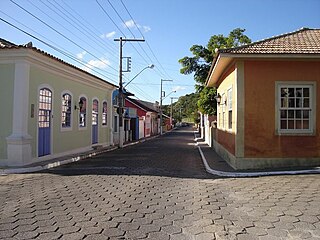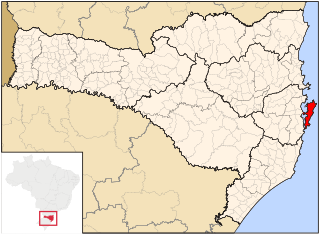| Florianopolitan dialect | |
|---|---|
| manezês, manezinho | |
 A view of Ribeirão da Ilha, an Azorean settlement in Florianópolis, where Florianopolitan dialect is traditionally spoken. | |
| Region | Florianópolis |
| Ethnicity | Azorean Brazilians |
Early form | |
| Portuguese alphabet | |
| Language codes | |
| ISO 639-3 | – |
 Florianópolis in Santa Catarina (state), Brazil. | |
Florianopolitan dialect, informally called manezês or manezinho,[1] is a variety of Brazilian Portuguese heavily influenced by (and often considered an extension of) the Azorean dialect.[2][3][4] It is spoken by inhabitants of Florianópolis (the capital of Santa Catarina state) of full or predominant Azorean descent[5][6] and in cities near the capital but with slight variations.[5] The dialect was originally brought by immigrants from Azores who founded several settlements in the Santa Catarina island from the 18th century onwards. The isolation of their settlements[7] made Florianopolitan differ significantly from both Standard European and Brazilian Portuguese.[8]
Once widely spoken in the Santa Catarina island, the Florianopolitan dialect is now almost restricted to the traditional Azorean settlements, and the standard Brazilian Portuguese became the predominant variant for the island inhabitants, many of which come from other parts of Santa Catarina state, other Brazilian states, or even other countries.[9]
- ^ Lima, Ronaldo; Souza, Ana Cláudia de (2005). "Flutuação de sentido: um estudo na Ilha de Santa Catarina" [Fluctuation of Meaning: A Study on the Island of Santa Catarina]. Revista Philologus (in Portuguese). 11 (33).
- ^ "I Congresso Internacional de Gestão de Tecnologia e Sistemas de Informação: Florianópolis" (in Portuguese). Archived from the original on 2011-07-06.
- ^ Nascimento, Leila Procópia do; Guimarães, Valeska Nahas (2019). "Reestruturação econômica e suas implicações no trabalho e na educação: relações de gênero em contexto" [Economic Restructuring and Its Implications for Work and Education: Gender Relations in Context]. Revista Trabalho Necessário. 7 (9). doi:10.22409/tn.7i9.p6098.
- ^ Haupt, Carine (2007). Sibilantes coronais – o processo de palatalização e a ditongação em sílabas travadas na fala de florianopolitanos nativos: uma análise baseada na fonologia da geometria de traços [Coronal Sibilants – the Palatalization Process and Diphthongization in Syllables Caught in the Speech of Native Florianopolitans: An Analysis Based on the Phonology of Trace Geometry] (PDF) (master's thesis) (in Portuguese). Universidade Federal de Santa Catarina.
- ^ a b Monguilhott, Isabel de Oliveira e Silva (2007). "A variação na vibrante Florianopolitana: um estudo sócio-geolingüístico" [Variation in Vibrant Florianopolitana: A Socio-Geolinguistic Study] (PDF). Revista da ABRALIN (in Portuguese). 6 (1): 147–169. Archived from the original (PDF) on 2011-07-24.
- ^ Görski, Edair Maria; Coelho, Izete Lehmkuhl (2009). "Variação linguística e ensino de Gramática" [Linguistic Variation and Grammar Teaching]. Working Papers em Linguística (in Portuguese). 10 (1): 73–91. doi:10.5007/1984-8420.2009v10n1p73.
- ^ Muniz, Yara Costa Netto (2008). Comunidades semi-isoladas fundadas por Açorianos na Ilha de Santa Catarina [Semi-Isolated Communities Founded by Azoreans on Santa Catarina Island] (doctor's thesis) (in Portuguese). Faculdade de Medicina de Ribeirão Preto. Archived from the original on 2012-09-09.
- ^ Rogers, Francis Millet (1947). "Brazil and the Azores". Modern Language Notes. 62 (6): 361–370. doi:10.2307/2909270. JSTOR 2909270.
- ^ Peluso Júnior, Victor Antônio, O crescimento populacional de Florianópolis e suas repercussões no plano e na estrutura da cidade [The Population Growth of Florianópolis and Its Repercussions on the Plan and Structure of the City] (PDF) (in Portuguese), archived from the original (PDF) on 2011-07-06
© MMXXIII Rich X Search. We shall prevail. All rights reserved. Rich X Search
